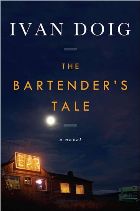
![]()
By Ivan Doig
Riverhead Books, $27.95, 387 pages
“As the father who was doing his bachelor best to raise me would have said, I didn’t lack imagination in the first place, and I certainly had no shortage of it as the clandestine eyewitness – or – earwitness – to the variety of life as it passed through the Medicine Lodge.” Tom Harry is the father, and the narrator is his son Russell, or Rusty to his friends and family. Medicine Lodge is the “legendary” family bar that sits in the town of Gros Ventre, Montana, and is the anchor for most of the action in this book. The Bartender’s Tale begins when “Pop” rescues Rusty from his Aunt Marge’s charge in Phoenix, where he’s lived with his two cousins since he was a baby. Together they head back to Medicine Lodge where life is rich with fishing, sheep herding, and hanging out in the back room of the bar listening through a vent in the wall to patrons sharing stories. However, the early circumstances of Rusty’s youth, including the fact that his mother deserted him, makes him a nervous boy, especially when his father disappears mysteriously to Canada for days at a time. Most of the story takes place in the summer of 1960, when Rusty turns 12. He meets his soulmate Zoe and a few other newcomers who turn his world on end and deepen the mysteries that surround his family.
Doig is a master of Americana details, and he layers this old-fashioned family saga with considerable nostalgic charm.
Reviewed by Diane Prokop
[amazon asin=1594487359&text=Buy On Amazon&template=carousel]
